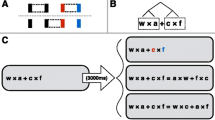Abstract
This study investigated, in the context of mathematical problem solving by secondary school students, the nature of the visual schemata which Johnson (1987) hypothesises mediate between logical propositional structures and “rich” specific visual images. Four groups of grade 10 students were studied, representing all combinations of high and low operational ability in mathematics (equivalent to Johnson's logical propositional structures) and high and low vividness of visual imagery (corresponding to Johnson's “rich” images). The results suggested first, that success at problem solving was related to logical operational ability, but not to vividness of visual imagery. Second, a variety of visually based strategies were used during problem solving which differed in their level of generality and abstraction, and use of these strategies appeared related to either logical operational ability or vividness of visual imagery, depending on their level of abstraction. The results supported Presmeg's (1992b) continuum of abstraction of image schemata.
Similar content being viewed by others
References
Armbruster, B. B.: 1989, ‘Metacognition in creativity’, in J. A. Glover, R. R. Ronning and C. R. Reynolds (eds.).Handbook of Creativity, Plenum Press, New York.
Biggs, J. B. and Collis, K. F.: 1991, ‘Multimodal learning and the quality of intelligent behaviour’, in H. A. H. Rowe (ed.).Intelligence: Reconceptualization and measurement, Erlbaum, Hillsdale, NJ 57–75.
Bishop, A. J.: 1989, ‘Review of research on visualization in mathematics education’,Focus on Learning Problems in Mathematics 11, 7–16.
Bruner, J. S.: 1964, ‘The course of cognitive growth’,American Psychologist 19, 1–15.
Carraher, T. N., Carraher, D. W. and Schliemann, A. D.: 1985, ‘Mathematics in the streets and in schools’,British Journal of Developmental Psychology 3, 21–29.
Collis, K. F.: 1975,A study of Concrete and Formal Operations in School Mathematics: A Piagetian Viewpoint. ACER, Melbourne.
Collis, K. F. and Biggs, J. B.: 1991, ‘Developmental determinants of qualitative aspects of school learning’, in G. Evans (ed.).Learning and Teaching Cognitive Skills ACER, Melbourne, 185–207.
Davis, R. B.: 1984,Learning Mathematics: The Cognitive Science Approach to Mathematics Education, Routledge, London.
Davis, R. B.: 1986, ‘The convergence of cognitive science and mathematics education’,The Journal of Mathematical Behavior 5, 321–333.
Hadamard, J.: 1954,The Psychology of Invention in the Mathematical Field. University Press, Princeton, NJ.
Johnson, M.: 1987,The Body in the Mind: The Bodily Basis of Meaning, Imagination and Reason. University of Chicago Press, Chicago.
Kaufmann, G. and Helstrup, T.: 1985, ‘Mental imagery and problem solving: Implications for the educational process’, in A. A. Sheikh and K. S. Sheikh (eds.).Imagery in Education, Baywood, New York 75 113–144.
Krutetskii, V. A.: 1976,The Psychology of Mathematical Abilities in School Children. University of Chicago Press, Chicago.
Lave, J.: 1988,Cognition in Practice: Mind, Mathematics, and Culture in Everyday Life. Cambridge University Press, New York.
Maher, C. A. and Alston, A.: 1989), ‘Is meaning connected to symbols? An interview with Ling Chen’,Journal of Mathematical Behaviour 8, 241–248.
Moses, B.: 1982, ‘Visualization: A different approach to problem solving’,School Science and Mathematics 82, 141–147.
Presmeg, N. C.: 1986a, ‘Visualisation and mathematical giftedness’,Educational Studies in Mathematics 17, 297–311.
Presmeg, N. C.: 1986b, ‘Visualisation in high school mathematics’,For the Learning of Mathematics 6, 42–46.
Presmeg, N. C.: 1992a, Book review: M. Johnson, ‘The body in the mind: The bodily basis of meaning, imagination and reason’,Educational Studies in Mathematics 23, 307–314.
Presmeg, N. C.: 1992b, ‘Prototypes, metaphors, metonymies and imaginative rationality in high school mathematics’,Educational Studies in Mathematics 23, 595–610.
Resnick, L. B.: 1987, ‘Learning in school and out’,Educational Researcher 16, 13–20.
Scribner, S.: 1984, ‘Studying working intelligence, in: B. Rogoff and J. Lave (eds.).Everyday Cognition: Its Development in Social Context. Harvard University Press, Cambridge, M.A. 9–40.
Shaw, G. A. and DeMers, S. T.: 1986, ‘The relationship of imagery to originality, flexibility and fluency in creative thinking’,Journal of Mental Imagery 10, 65–74.
Sheehan, P. W.: 1967, ‘A shortened form of Betts questionnaire upon mental imagery’,Journal of Clinical Psychology 23, 386–389.
Shepard, R.: 1988, ‘The imagination of the scientist’, in K. Egan and D. Nadaner (eds.).Imagination and Education, Teachers College Press, New York, 153–185.
Walkup, L. E.: 1965, Creativity in science through visualization,Perceptual and Motor Skills 21, 35–41.
Watson, J. M.: 1988, ‘Three hungry men and strategies for problem solving’,For the Learning of Mathematics 8(3), 20–26.
Watson, J. M., Campbell, K. J. and Collis, K. F.: 1993, ‘Multimodal functioning in understanding fractions’,Journal of Mathematical Behaviour 12, 45–62.
Wheatley, G. H.: 1991, ‘Enhancing Mathematics learning through imagery’,Arithmetic Teacher, 39, (1), 34–36.
Author information
Authors and Affiliations
Additional information
Throughout the paper, the first “High” or “Low” denotes logical operational ability, and the second, vividness of visual imagery.
Rights and permissions
About this article
Cite this article
Campbell, K.J., Collis, K.F. & Watson, J.M. Visual processing during mathematical problem solving. Educ Stud Math 28, 177–194 (1995). https://doi.org/10.1007/BF01295792
Issue Date:
DOI: https://doi.org/10.1007/BF01295792




